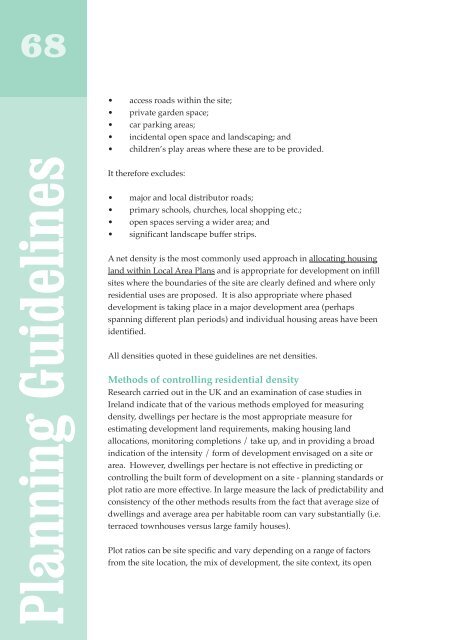Sustainable Residential Development in Urban Areas
Sustainable Residential Development in Urban Areas
Sustainable Residential Development in Urban Areas
Create successful ePaper yourself
Turn your PDF publications into a flip-book with our unique Google optimized e-Paper software.
68<br />
Plann<strong>in</strong>g Guidel<strong>in</strong>es<br />
• access roads with<strong>in</strong> the site;<br />
• private garden space;<br />
• car park<strong>in</strong>g areas;<br />
• <strong>in</strong>cidental open space and landscap<strong>in</strong>g; and<br />
• children’s play areas where these are to be provided.<br />
It therefore excludes:<br />
• major and local distributor roads;<br />
• primary schools, churches, local shopp<strong>in</strong>g etc.;<br />
• open spaces serv<strong>in</strong>g a wider area; and<br />
• significant landscape buffer strips.<br />
A net density is the most commonly used approach <strong>in</strong> allocat<strong>in</strong>g hous<strong>in</strong>g<br />
land with<strong>in</strong> Local Area Plans and is appropriate for development on <strong>in</strong>fill<br />
sites where the boundaries of the site are clearly def<strong>in</strong>ed and where only<br />
residential uses are proposed. It is also appropriate where phased<br />
development is tak<strong>in</strong>g place <strong>in</strong> a major development area (perhaps<br />
spann<strong>in</strong>g different plan periods) and <strong>in</strong>dividual hous<strong>in</strong>g areas have been<br />
identified.<br />
All densities quoted <strong>in</strong> these guidel<strong>in</strong>es are net densities.<br />
Methods of controll<strong>in</strong>g residential density<br />
Research carried out <strong>in</strong> the UK and an exam<strong>in</strong>ation of case studies <strong>in</strong><br />
Ireland <strong>in</strong>dicate that of the various methods employed for measur<strong>in</strong>g<br />
density, dwell<strong>in</strong>gs per hectare is the most appropriate measure for<br />
estimat<strong>in</strong>g development land requirements, mak<strong>in</strong>g hous<strong>in</strong>g land<br />
allocations, monitor<strong>in</strong>g completions / take up, and <strong>in</strong> provid<strong>in</strong>g a broad<br />
<strong>in</strong>dication of the <strong>in</strong>tensity / form of development envisaged on a site or<br />
area. However, dwell<strong>in</strong>gs per hectare is not effective <strong>in</strong> predict<strong>in</strong>g or<br />
controll<strong>in</strong>g the built form of development on a site - plann<strong>in</strong>g standards or<br />
plot ratio are more effective. In large measure the lack of predictability and<br />
consistency of the other methods results from the fact that average size of<br />
dwell<strong>in</strong>gs and average area per habitable room can vary substantially (i.e.<br />
terraced townhouses versus large family houses).<br />
Plot ratios can be site specific and vary depend<strong>in</strong>g on a range of factors<br />
from the site location, the mix of development, the site context, its open

















